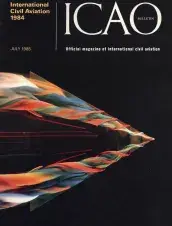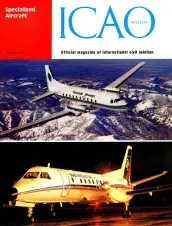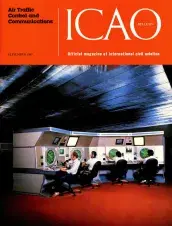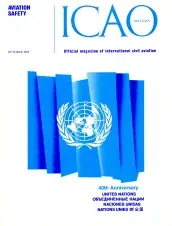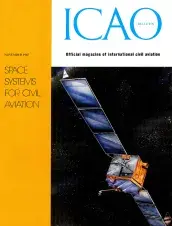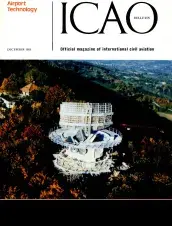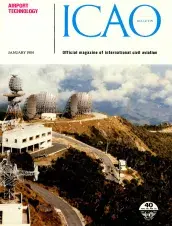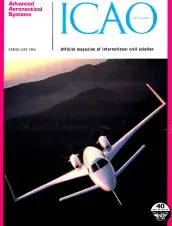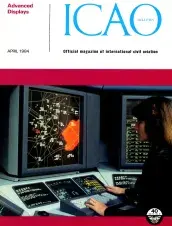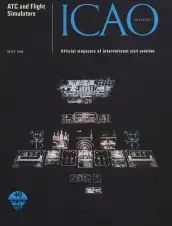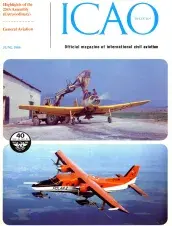ICAO Journal
The objective of the Journal is to provide a concise account of the activities of the International Civil Aviation Organization and to feature additional information of interest to Contracting States and the international aeronautical world.
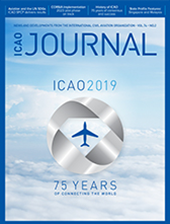 (ICAO Journal is available in English only from 2013)
(ICAO Journal is available in English only from 2013)
New techniques which are shaping the future of aviation also help produce unexpected works of art, as seen from this striking photograph taken at the French Aerospace Research Centre (ONERA). Here, coloured tracer fluids are used to obtain a visual representation of hydraulic flow. The cone-shaped layers are on the upper surface of a delta wing.
This is a portion of the air traffic control consoles at the Geneva area control centre. The ACC currently handles from 800-1,200 movements a day. As part of an overall systems update, a new flight-plan processing concept has been introduced at Geneva-Cointrin Airport -- for details, see story beginning on page 36.
This artist's impression shows the second-generation communications satellite now in development for the global maritime communications system operated by INMARSAT. The satellite utilizes the Eurostar platform being developed by British Aerospace in conjunction with Matra, the French aerospace company. The specialized communications payload will be provided by Hughes Aircraft Company in California. The spaceborne electronics will make provision for future testing of aeronautical links.
The Westinghouse ARSR-3 installed at Laegern, Switzerland, is a minimally attended, long range coherent L-band radar. Originally designed and built for the U.S. Federal Aviation Administration for fixed and mobile installations, it uses advanced radar techniques to detect even small aircraft in the presence of heavy clutter; it provides coverage out to 370 km in range with a 30-kin elevation against a two-m 2 target.
Based on a study undertaken by the Air Ministry of Brazil in 1968, it was decided to integrate the nation's civil and military air traffic control systems to minimize cost and maximize performance. These radar antennas installed at Pico do Couto, Petropolis, near Rio de Janeiro, form part of this integrated air defense and air traffic control (DACTA) system; the mountain-top installation services the areas encompassing Brasilia, Rio de Janeiro and Sao Paulo. The overall AIRCAT system developed by Thomson-CSF is capable of handling 5000 daily flight plans, of which 600 occur regularly during peak periods. It can also handle some 150 movements simultaneously. This installation represents the first phase in a master plan to cover the entire country.
This head-on view of the new Beechcraft Starship 1 design clearly shows some of its unusual features, such as the tandem wings and extended winglets — these control surfaces are over 2.3 metres long, rising from the tips of the larger aft swept wing. Power is derived from twin pusher propfans, located inboard, above and to the rear of the aft wing. The shorter length forward wing employs variable geometry.
The Netherlands Department of Civil Aviation has taken delivery and put into operation a Citation 500 aircraft (inset) equipped with a computerized flight inspection system to evaluate the performance and to calibrate ground navigational facilities. The system, designed by Sierra Research Corporation and believed to be the first of its kind, will be used to inspect ILS facilities to Category-III standards. Besides ILS, the system can also inspect VOR, DME, ADF and VHF facilities. In the past, computerized flight inspection systems did not have the overall accuracy necessary to evaluate ILS facilities to Category-III requirements. The system shown includes a console with specialized receivers, together with controls and displays that enable the flight inspector to monitor operation of the airborne system.
Prototype shown is a candidate "Sector Suite" in an ongoing competition now under way by the U.S. Federal Aviation Administration for use in its upgraded National Airspace System. Some 1,400 of the ATC work stations will be required at nearly 30 area control centres across the United States. For details on this three-console complex using advanced displays developed by Gould lnc., see story beginning on page 9 herein.
With simulator cabin lights out, we obtain an eerie view of Lockheed-Georgia's Pilot's Desk Flight Station. This is one of three such research facilities to be used for advanced aeronautical studies and for the testing of some cockpit instrumentation. Five cathode ray tube (CRT) displays are provided; touch panels are used to control some of the presentations when needed by the crew. Bulky control columns have been replaced by side-arm controllers, which would accompany future fly-by-wire or fly-by-light control systems.
Aircraft at work is clearly shown here: (top) Czechoslovakia's Z-37A, a versatile agricultural aircraft, used in many countries, is being loaded for another chemical application to farm land; (bottom) Fed. Rep. of Germany's Dornier 228-100 as it was outfitted for its recent participation in a research programme in the South Polar Region.
